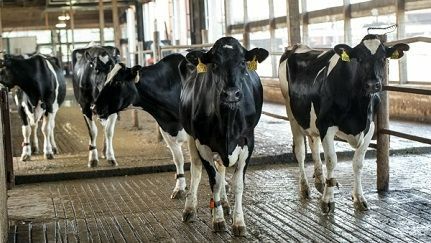Dairy farm chemicals keep equipment clean and animals healthy on many modern dairy farms. But when mishandled, they can lead to the contamination of milk and milk products. Dairy cross-contamination can cause health problems for farmers, animals and milk consumers.
In general, consider these steps to help keep dairy farm cleaning chemicals from being a source of milk contamination:
- Monitor and document chemical use
- Follow label instructions and dairy best management practices
- Conduct regular, frequent inspections of farms and animals
- Train workers on how to properly handle and administer chemicals on the farm
- Update protocols regularly based on chemicals used
“All workers and contractors should be trained. Include education on chemical usage, documentation and proper storage and application,” said Nationwide Agribusiness Senior Risk Management Consultant Lance Reeve. “When a new chemical is introduced onto the farm, train workers on potential hazards of that product. Account for any special handling requirements and ways to prevent exposure.”
Minimize antibiotic milk contamination risks
Dairy antibiotics help keep cows healthy and productive. But every farmer must make sure milk is free of even a trace of them before it leaves the farm. Work with a veterinarian and keep detailed records on specific products, their doses and when they’re given. Many antibiotics have labeled withdrawal periods. Observe those times to help keep them out of the consumer dairy supply chain.
“Review records regularly with a veterinarian who visits the farm,” Reeve said. “All farm workers need to know the importance of following protocols for antibiotic use. This training is vital to preventing cross-contamination.”
Build a chemical control program
There are a lot of other chemicals used on dairy farms. Account for the following product types in a chemical control program for your farm:
- Cleaners
- Sanitizers
- Lubricants
- Other animal treatments and medications
The program should include how you will take care of potential chemical residues in animals, barns and on equipment. Follow all specific product label instructions or warnings about cross-contamination and safe handling. Finally, have a plan for how you will eliminate those residues to prevent chemical contaminants in milk.
“Ensure you are appropriately managing all chemicals to protect employees and the milk,” Reeve said. “For example, many cleaners are concentrated. If you dilute one before you use it, follow label instructions. Then, verify and document those steps.”
Don’t take shortcuts
When you have a barn full of cows to be milked, it can be easy to take shortcuts. It’s sometimes tough to resist the urge to do things like reuse containers, for example. But doing so can cause exposure even when all other protocols are closely followed.
A final part of managing chemicals on a dairy farm is managing your workforce. Make sure only your workers and other approved personnel are allowed on the farm. Store chemicals securely and allow only trained, authorized workers access to them.
“Every worker on the farm needs to know mishandling chemicals creates a risk to themselves and the milk,” Reeve said. “All workers need general chemical training and education on protocols like safe storage and prohibited uses of unapproved chemicals.”
